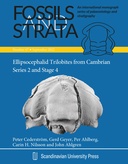Explore

Ellipsocephalid trilobites from Cambrian Series 2 and Stage 4
0 Ungluers have
Faved this Work
Login to Fave
The taxonomically difficult ellipsocephalid trilobites from upper lower Cambrian (unnamed Stage 4) strata in Scandinavia are reviewed and revised. The suggested generic identities illustrate the diversification of the Ellipsocephalinae and advocate a modified correlation of the late to latest early Cambrian strata in Scandinavia and Baltica. The study is based primarily on material from the Gislöv Formation in Scania, southern Sweden, from which several species were originally known only from sparse and poorly preserved material. These are now described in more completeness and partly based on material that allows characterisation of ontogenetic developments. The hitherto inadequately characterized and poorly described genera and species include Epichalnipsus Geyer, Popp, Weidner & Förster, 2004 with E. bergstroemi n. sp. and E. rotundatus (Kiær, 1917), Kingaspidoides Hupé, 1953 with K. nordenskioeldi (Linnarsson, 1883) and K. lunatus (Bergström & Ahlberg, 1981), Ellipsostrenua Kautsky, 1945 with E. gripi (Kautsky, 1945), E. linnarssoni (Kiær, 1917), E. sularpensis (Ahlberg & Bergström, 1978), E. brevifrons n. sp., E. simrica n. sp., E. troedssoni n. sp., and E. spinosa (Ahlberg & Bergström, 1978), Dellingia n. gen. with D. scanica (Ahlberg & Bergström, 1978), and Cuneoaxiella n. gen. with C. grandis (Ahlberg & Bergström, 1978). In order to present a coherent concept of subfamilies and genera within the family Ellipsocephalidae, several genera and species from outside Scania and Sweden are reviewed and partly revised. Additional new taxa and new combinations include the subfamily Strenuaevinae n. subfam., Epichalnipsus kullingi (Ahlberg & Bergström, 1978), Berabichia baltica (Wiman, 1903), and Cambrosaurura n. gen. with C. usitata (Geyer, 1990), C. robusta n. sp., C. bommeli n. sp. and C.? todraensis (Geyer, 1990). Morphotype differentiation is recognized within Dellingia scanica and E. bergstroemi n. sp. Measured and calculated linear dimensions of the individual parts of the cranidium and the exoskeletal ornamentation have proven to be of taxonomic significance for distinguishing closely related species. The width/length ratio of cranidia and the dimensions of their individual parts also provides clues for the mode of growth, and the ontogenetic development is described in Ellipsostrenua linnarssoni and E. brevifrons. The revised taxonomy and more precise data of the species ranges in the Gislöv Formation suggest a revision of the biostratigraphy in Cambrian Stage 4 of Scania and Scandinavia in general, with a subdivision into a Holmia kjerulfi Zone (revised), an Ellipsostrenua spinosa Zone and a Dellingia scanica-Kingaspidoides lunatus Zone. Despite the extremely condensed development of the Gislöv Formation and the overlying beds, considerable differences can be detected in the sections in Scania. Regional and intercontinental correlations are discussed. It is shown that the Dellingia scanica-Kingaspidoides lunatus Zone and probably also the Ellipsostrenua spinosa Zone correlates with paradoxidine-bearing strata in West Gondwana hitherto assigned to the middle Cambrian. Thus, the earliest paradoxidines from Scandinavia are late by comparison with those of several other regions. The regression which caused the hiatus between the traditional lower and middle Cambrian strata in Scania and Scandinavia does not correlate precisely with the gaps recorded in other Cambrian continents such as West Gondwana or eastern Laurentia, and the new term Baltic Basin Regression is suggested.
This book is included in DOAB.
Why read this book? Have your say.
You must be logged in to comment.
